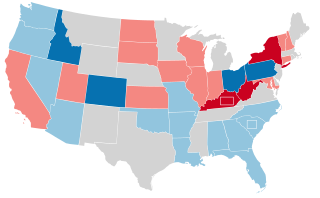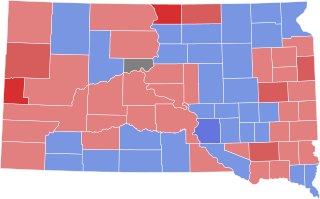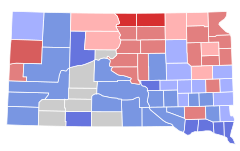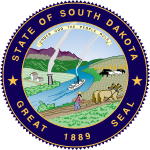
The 1996 United States Senate elections were held on November 5, with the 33 seats of Class 2 contested in regular elections. Special elections were also held to fill vacancies. They coincided with the presidential election of the same year, in which Democrat Bill Clinton was re-elected president.

The 1972 United States Senate elections were held on November 7, with the 33 seats of Class 2 contested in regular elections. They coincided with the landslide re-election of Republican President Richard Nixon. Despite Nixon's landslide victory, Democrats increased their majority by two seats. The Democrats picked up open seats in Kentucky and South Dakota, and defeated four incumbent senators: Gordon Allott of Colorado, J. Caleb Boggs of Delaware, Jack Miller of Iowa, and Margaret Chase Smith of Maine. The Republicans picked up open seats in New Mexico, North Carolina, and Oklahoma, and defeated one incumbent, William B. Spong Jr. of Virginia.

The 1970 United States Senate elections was an election for the United States Senate. It took place on November 3, with the 33 seats of Class 1 contested in regular elections. Special elections were also held to fill vacancies. These races occurred in the middle of Richard Nixon's first term as president. The Democrats lost a net of three seats, while the Republicans and the Conservative Party of New York picked up one net seat each, and former Democrat Harry F. Byrd Jr. was re-elected as an independent.

The 1968 United States Senate elections were elections for the United States Senate. Held on November 5, the 34 seats of Class 3 were contested in regular elections. They coincided with the presidential election of the same year. The Republicans picked up five net seats in the Senate. This saw Republicans win a Senate seat in Florida for the first time since Reconstruction.

The 1964 United States Senate elections were held on November 3. The 33 seats of Class 1 were contested in regular elections. Special elections were also held to fill vacancies. They coincided with the election of President Lyndon B. Johnson by an overwhelming majority, to a full term. His Democratic Party picked up a net two seats from the Republicans. As of 2023, this was the last time either party has had a two-thirds majority in the Senate, which would have hypothetically allowed the Senate Democrats to override a veto, propose constitutional amendments, or convict and expel certain officials without any votes from Senate Republicans. In practice, however, internal divisions effectively prevented the Democrats from doing so. The Senate election cycle coincided with Democratic gains in the House in the same year.

The 1962 United States Senate elections was an election for the United States Senate. Held on November 6, the 34 seats of Class 3 were contested in regular elections. Special elections were also held to fill vacancies. They occurred in the middle of President John F. Kennedy's term. His Democratic Party made a net gain of four seats from the Republicans, increasing their control of the Senate to 68-32. However, this was reduced to 67-33 between the election and the next Congress, as on November 18, 1962, Democrat Dennis Chávez, who was not up for election that year, died. He was replaced on November 30, 1962, by Republican appointee Edwin L. Mechem. Additionally, Democrat Strom Thurmond became a Republican in 1964, further reducing Democrats to 66-34. This was the first time since 1932 that Democrats gained seats in this class of Senators.

The 1956 United States Senate elections were elections for the United States Senate that coincided with the re-election of President Dwight D. Eisenhower. The 32 seats of Class 3 were contested in regular elections, and three special elections were held to fill vacancies. Although Democrats gained two seats in regular elections, the Republicans gained two seats in special elections, leaving the party balance of the chamber unchanged.

The 1914 United States Senate elections, with the ratification of the 17th Amendment in 1913, was the first time that all seats up for election were popularly elected instead of chosen by their state legislatures. And thus it became the first time that they were generally scheduled on Election Day to coincide with the U.S. House elections. The 32 seats of Class 3 were contested in regular elections in 1914. Special elections were also held to fill vacancies. These elections occurred in the middle of Democratic President Woodrow Wilson's first term.

William Henry McMaster was an American politician who served as the tenth Governor of South Dakota from 1921 until 1925. A member of the Republican Party, he went on to serve as a member of the United States Senate from South Dakota from 1925 to 1931.

The 1912–13 United States Senate elections were held on various dates in various states. They were the last U.S. Senate elections before the ratification of the Seventeenth Amendment in 1913, establishing direct elections for all Senate seats. Senators had been primarily chosen by state legislatures. Senators were elected over a wide range of time throughout 1912 and 1913, and a seat may have been filled months late or remained vacant due to legislative deadlock. Some states elected their senators directly even before passage of Seventeenth Amendment. Oregon pioneered direct election and experimented with different measures over several years until it succeeded in 1907. Soon after, Nebraska followed suit and laid the foundation for other states to adopt measures reflecting the people's will. By 1912, as many as 29 states elected senators either as nominees of their party's primary or in conjunction with a general election.

The 1904 South Dakota gubernatorial election was held on November 8, 1904. Incumbent Republican Governor Charles N. Herreid declined to run for re-election to a third term. Clark County State's Attorney Samuel H. Elrod won the Republican nomination to run as Herreid's successor, and he faced Democratic nominee Louis N. Crill, the former President of the State Senate, and former U.S. Congressman Freeman Knowles, the Socialist nominee. For the first time since 1894, the Democratic and Populist Parties nominated separate candidates. Ultimately, the split in the two parties did not prove dispositive; Elrod defeated Crill and the other candidates in a landslide.

The 1906 South Dakota gubernatorial election was held on November 6, 1906. Incumbent Republican Governor Samuel H. Elrod ran for re-election, but was defeated for renomination at the Republican convention by former Attorney General Coe I. Crawford. In the general election, Crawford was opposed by the Democratic nominee, former State Representative John A. Stransky of Brule County. Crawford had little difficulty defeating Stransky in a landslide, largely matching Elrod's margin of victory from two years earlier.

The 1950 United States Senate election in South Dakota took place on November 7, 1950. Incumbent Republican senator Chan Gurney ran for re-election to a third term. He was challenged in the Republican primary by Congressman Francis H. Case, who had represented the 2nd District since 1939. In the general election, Case faced John A. Engel, an attorney and the 1948 Democratic nominee for the U.S. Senate. As the Republican Party was making significant gains nationwide, Case defeated Engel in a landslide.

The 1918 United States Senate election in South Dakota took place on November 5, 1918. Incumbent Republican Senator Thomas Sterling sought re-election in his first popular election. He defeated former Governor Frank M. Byrne in the Republican primary and then faced former State Representative Orville Rinehart, the 1916 Democratic nominee for Governor, in the general election. Sterling defeated Rinehart, along with independent candidate W. T. Rafferty, by a wide margin to win re-election.

The 1962 United States Senate election in South Dakota took place on November 6, 1962. Incumbent Republican Senator Francis H. Case ran for re-election to a third term. He won the Republican primary against Attorney General A. C. Miller, but shortly after the primary, died. The Republican State Central Committee named Lieutenant Governor Joseph H. Bottum as Case's replacement on the ballot, and Governor Archie Gubbrud appointed Bottum to fill the vacancy caused by Case's death. In the general election, Bottum was opposed by Democratic nominee George McGovern, the Director of Food for Peace and the former U.S. Congressman from South Dakota's 1st congressional district. The contest between Bottum and McGovern was quite close, with McGovern narrowly defeating him for election by just 597 votes, making him the first Democrat to win a Senate election in South Dakota since William J. Bulow's win in 1936.

The 1912 United States presidential election in South Dakota took place on November 5, 1912, as part of the 1912 United States presidential election. Voters chose five representatives, or electors, to the Electoral College, who voted for president and vice president.

The 1908 South Dakota gubernatorial election was held on November 3, 1908. Incumbent Republican Governor Coe I. Crawford opted to run for the U.S. Senate rather than run for re-election. State Senator Robert S. Vessey narrowly won the Republican primary over former State Representative John L. Browne and advanced to the general election, where he faced the Democratic nominee, former Governor Andrew E. Lee. Though Vessey's performance was significantly reduced from Crawford's performance in 1906, he still defeated Lee by a wide margin.

The 1912 South Dakota gubernatorial election was held on November 5, 1912. Incumbent Republican Governor Robert S. Vessey declined to run for re-election to a third term. Lieutenant Governor Frank M. Byrne won the Republican primary to succeed Vessey, and then faced State Senator Edwin S. Johnson, the Democratic nominee, in the general election. Byrne only narrowly defeated Johnson, winning just 49% of the vote to Johnson's 46%, the closest gubernatorial election since 1898.

The 1914 South Dakota gubernatorial election was held on November 3, 1914. Despite a close election in 1912, incumbent Republican Governor Frank M. Byrne defeated Democratic nominee James W. McCarter, an Edmunds County Judge, with 50.07% of the vote. Coincidently, Bryne's Democratic opponent in 1912, Edwin S. Johnson, was elected the same year to represent South Dakota in the United States Senate.

The 1938 United States Senate elections in South Dakota took place on November 8, 1938. Incumbent Republican Senator Peter Norbeck died in office on December 20, 1936. Herbert E. Hitchcock was appointed by Governor Tom Berry as Norbeck's replacement. Two elections for the same Senate seat were held on the same day; one as a special election to fill the remainder of Norbeck's six-year term, and another to select a Senator to serve the next six-year term.























